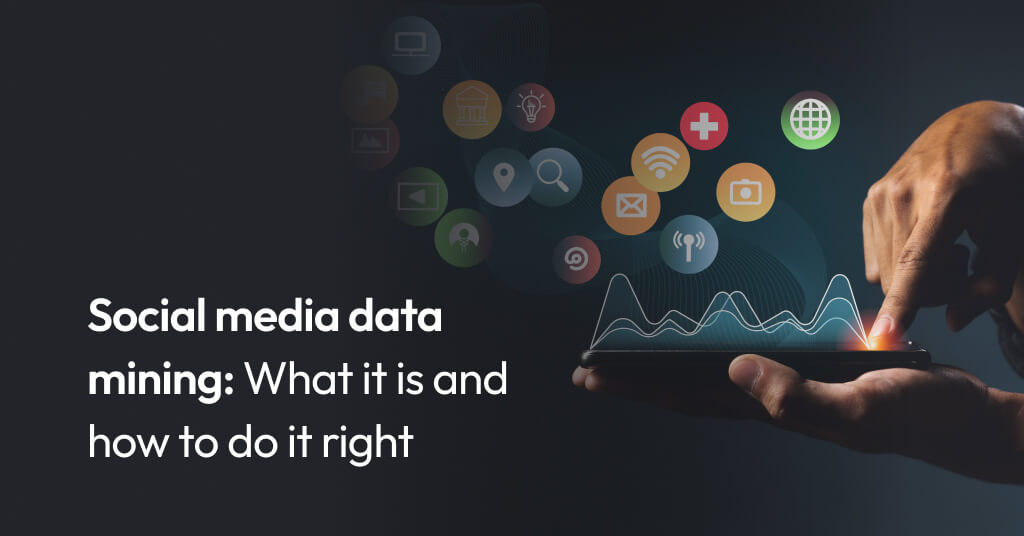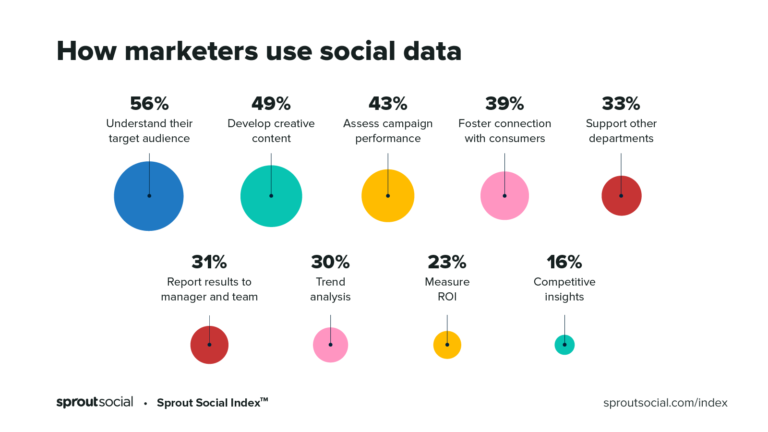
The web, social media in particular, is awash with valuable data that can be mined for strategic business insights. However, social media data mining is significantly underutilized. For most companies, social media are platforms meant only for communication and posturing.
With home to nearly five billion people, who together generate millions of content every passing moment, social media are a goldmine of useful data. For example, on Facebook, one of the leading platforms, more than a billion stories are shared each day.
Companies that successfully mine the flood of data generated on social media and use them to make informed decisions have a big advantage over those that do not.
Continue reading to learn more.
What Is Social Media Data Mining?
Social media data mining, also known as social media mining, is the process of collecting, processing, and analyzing the vast amount of raw data generated on social media platforms, such as Facebook, Instagram, Twitter (or X), LinkedIn, and TikTok.
The process of social media data mining involves using various techniques and tools to discover patterns, unearth sentiments, and find relevant information from user-generated content. The content may be posts, comments, and interactions. Some notable social media data mining techniques include identifying and clustering similar users, geospatial and temporal analyses to identify trends and patterns based on location and time, market analysis, predictive analytics, and sentiment analysis.
Social Media Data Mining: Why Do It?
Utilizing data from the web in ingenious ways can make much difference. The way social media data are harvested and used is one important factor that sets apart a flourishing business from a flagging one. This is because social media data mining plays a crucial role in all aspects of business operations—from the conception of a product to its maturity. It has a significant role in marketing, casting light on the four Ps: product, price, promotion, and place. And without the quality and quantity of data social media mining can provide, companies may struggle to connect with the audience intimately leading to ineffective marketing campaigns.

Social media mining also forms an essential component of business intelligence. It helps unearth valuable insights about customers and competitors. It gives important information on what is going on in the market. The goal, principally, is to gain a deeper understanding of user behavior, preferences, values, interests, and opinions, and uncover hidden trends and patterns. These insights are used to make informed decisions in introducing new products, designing marketing strategies, or improving existing processes or services.
On the flip side, ignoring social media data mining can be costly. Businesses risk losing touch with customers and failing to adapt to the market dynamics. This may result in failing to address customer needs promptly or adequately, missing opportunities, and ceding competitive advantage to rivals.
Real-world Applications Of Social Media Data Mining
Social media mining, if leveraged cleverly, can be game-changing. Here are some important ways social media data mining can be helpful to a business.
Honing brand perception
Social media play a crucial role in shaping brand perception. The platforms offer an excellent opportunity to engage with customers and present brands not just as an abstract, inanimate entity, but also allow them to strike the right cord with their audience and craft unique personas. However, to do that, they must first understand the user base, and that is facilitated by mining social media data.
Social media data mining can help companies assess what customers want, analyze their sentiments, monitor brand mentions across various platforms, and gauge public perception of its image. This lets brands proactively engage with customers and helps them foster a positive and favorable brand image in the eyes of their audience.
Social media mining also helps identify brand advocates and detractors. This allows engaging with them to promote brand image and address concerns to influence the overall brand perception.
Understanding customers better
Mining social network data allows businesses to understand customers at a more intimate level and fosters customer-centric business strategies. A preponderantly high number of business leaders say social media data are essential to gain a better understanding of customers.
Social media platforms contain useful information about customers such as their demographic details. Social media mining enables companies to analyze these details to understand the age, gender, location, and other related information about their customers. LinkedIn data mining can be especially helpful in obtaining the professional information and interests of audiences. Social media mining also makes it possible to closely monitor customer attitudes and feedback. And it provides direct insights into customer satisfaction.
This understanding is crucial for creating personalized engagement and improving customer experience. Mining social media data allows businesses to keep track of customers’ feedback, comments, conversations, or questions, and helps optimize social media engagement and curate interesting content.
Performing competitor analysis
Knowing one’s customers is just one part of the equation for a business to thrive. Another important component is keeping a watchful eye on competitors. There is hardly a better approach than mining social media data for this. Social media data mining is instrumental in gaining insights into competitors’ strategies, strengths, and weaknesses. This can help benchmark one’s own social media presence and identify areas for improvement.
It is also useful in analyzing customer sentiments about competitors. Monitoring brand mentions of competitors across social media platforms and understanding how they are perceived can be helpful in developing competitive strategies. This can also uncover areas competitors may be overlooking, helping companies to fill those gaps.
Identifying emerging trends
Social media is where trends either originate or gain momentum. However, the volume of data generated on social media platforms and the scale of activity make it difficult to identify patterns, let alone spot trends.
With a suitable social media data mining technique, identifying patterns and trends is easier. Instagram data mining, for instance, enables one to evaluate up-and-coming vogues among young adults by monitoring trending hashtags and keywords. Analyzing the frequency and context of the topics gaining popularity provides insights into emerging discussions and interests. This facilitates assessing the users’ sentiment around certain topics and their overall mood and perception.
And by analyzing historical social media data, companies can identify shifts and changes in user behavior over time, compare past and present trends and thus anticipate future developments. By proactively evaluating and anticipating emerging trends, companies can adapt their strategies, products, and services such that they align with evolving customer preferences and industry developments.
Enhancing marketing effectiveness
Social media data mining can help guide marketing strategies and enhance effectiveness. Analyzing social media data helps with the identification of distinct segments within the target audience and understanding their demographics, behavior, preferences, and values. This intimate knowledge and granular segmentation is instrumental in targeted and personalized marketing, ensuring that marketing campaigns are relevant and engaging.
Mining social media data can also help organizations identify influencers and thought leaders within specific industries who align with their brands and target audiences. Collaborating with people with a niche following can enhance the reach and impact of marketing campaigns and increase brand awareness.
Social Media Data Mining Process
The process of social media data mining involves a number of key aspects and it can seem daunting. The volume, variety, and velocity of the content generated on social media platforms are huge and any large-scale mining effort is challenging. But with the right tools and systematic execution, it is possible to effectively mine social media data in all their abundance.

The following are the key steps involved in the social media data mining process.
1. Data collection
The initial phase of the social media data mining process is the collection of raw data systematically from various platforms. This involves selecting the specific platforms and gathering the data using methods like APIs and web scraping to access relevant data. Since the density of information is a challenge, depending on the end goal, the scope of the social media data collection can be narrowed by applying filters based on keywords, hashtags, topics, users, location, or time.
This stage lays the groundwork for subsequent steps of the social media data mining process. It provides the raw material for analysis, interpretation, and extraction of actionable insights. So, it is important to carefully select the method for data collection, focusing on the sources and types of data relevant to analysis.
2. Data preprocessing
No matter the methods and tools used for collecting social media data, there will be duplicates, inaccuracies, and incompleteness in the data. This requires refining them.
This may include cleaning the data, filtering, transforming, and enriching to remove noise, duplicates, and errors, ensuring overall consistency in the dataset. The object is to transform the raw data into a well-organized and standardized format to facilitate accurate and reliable analysis. Preprocessing is a crucial step as it helps ensure the quality, validity, and reliability of the collected data.
3. Data analysis
This phase involves analyzing the preprocessed data to find patterns, trends, associations between data points, and uncovering insights. This could include identifying common words or phrases or the frequency of their occurrence, periods of high engagement, prevalent sentiments across posts, and how these are distributed geographically or temporally. The results thus obtained served as the foundation for informed decision-making and strategic planning.
Various analytical techniques may be employed to discover hidden trends and patterns. These include classification, clustering, association, regression, anomaly detection, and recommendation.
4. Visualization
The analyzed data and the results gathered do not fully give a clear picture. Visualization of the data is what gives better clarity and understanding. Data visualization helps bring key points and areas of prominence to the fore, revealing patterns and relationships that may otherwise remain hidden and allows for better comparison of the differences. It makes the data more interpretable and easy to grasp.
Visualization is not (only) about making the data presentable; it’s about facilitating the discovery of patterns. So choosing suitable formats for visualization is essential. Line graphs, for example, are suitable for visualizing temporal data, and linear regression graphs may be used to visualize correlations.
5. Interpretation and implementation
This stage of the social media data mining process involves making sense of the data and drawing conclusions from the results. What do the patterns and relationships signify? Do they have any meaningful association? How do they compare with results from the past? These and other questions need to be answered.
End note
Social media provide a wealth of information that can be mined suitably and used gainfully. While social media data mining has been around for years, it is only in recent years that social media data have been mined at scale. This is thanks to the advancements in tools and techniques for the extraction of social media data.
But the process of social media data mining remains daunting. However, that should not be an excuse to ignore it. There are specialized third parties that provide bespoke social media data mining services. They help companies capitalize on the streams of data available on social media platforms.
Frequently Asked Questions
How do I analyze social media data?
For analyzing social media data, raw data are collected from various social media platforms which are then preprocessed to make them fit and easier for analysis. Various analytical techniques may be used to discover hidden trends and patterns. The techniques include clustering, regression, classification, and association.
How does social media data mining work?
Social media data mining works by collecting data from social media platforms by using APIs and web scraping tools. These data are then cleaned, analyzed, and interpreted for actionable insights.
What is the first step of social media mining?
The first step of social media data mining is the collection of data. Depending on the objective of the social media mining, the social media platform of choice is selected and data are extracted using suitable tools or techniques.

Pavan Kakar
Pavan Kakar is the Associate Vice President of International Sales (Digital Division) at SunTec India and has been associated with the company for over 25 years. His core expertise lies in customer relationship management, project management, resource management, management information systems(MIS), and lead generation. In between his packed schedule, he finds time to pen down informative articles to educate readers on how they can drive business value in the constantly evolving digital landscape.

